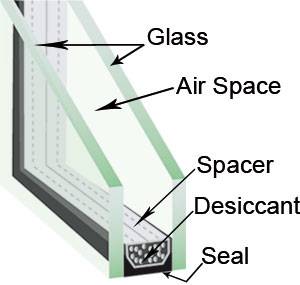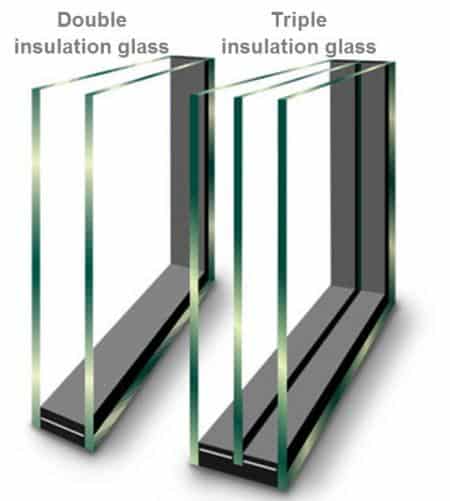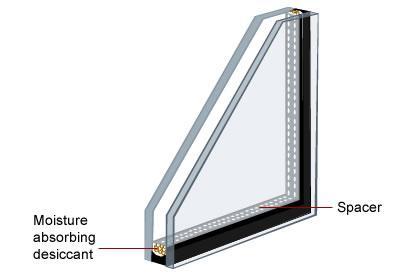What is Double Glazing Vs Retrofit Double Glazing? – Which is right for your home?
A well-insulated house helps you maintain optimum temperature throughout all seasons. It protects you against cold in winter and heat in summer. This way you spend less on additional heating and cooling systems which makes insulating your home a very good investment. Insulation also provides a healthy environment for your home by preventing the build up of mould.
The four main areas that you can expect heat loss is your ceilings, walls, floors, and windows. In this article we will delve further into insulating windows and glass doors for homes in Auckland.
Single glazed windows (or pane of glass) has been insulating and protecting our homes for centuries, but is there anything better than glass? The answer to this is double glazed windows and doors.
Most new built homes have double glazing in accordance with New Zealand building code. However most older homes have standard glass for their windows and are struggling to keep their homes healthy which are often prone to moulding or they are paying high electricity bills for cooling/heating systems.
In this article we will discuss the following:
- What is double glazing, triple glazing and Secondary glazing?
- 4 Factors that affect the performance of your double glazing (Spacers, type of glass, still air Vs gas and correct installation)
- R rating for windows and what is right for you?
- Pros and Cons of Double Glazing – Make a wise choice.
- How much does it cost to install double glazing in Auckland?
- Cost comparison between New double glazing, Retrofitting double glazing and Secondary glazing
- Retrofitting Double glazing or Double glazing/ brand new windows (new frames + IGU) – What is right for your home?
Cost Calculator for Double Glazing Windows
This New Double Glazing Cost Calculator (Updated on August 2021 to reflect market prices of product and labour) is designed only for you to get an indication of what you can expect to invest based on the provided information.
Try it here: https://superiorrenovations.co.nz/double-glazing-cost-calculator-nz/
What are Double Glazed Windows?
What is Double Glazing (Brand new windows + Insulated glass unit + New window frames)?
Glazing was a middle English term used for glass. A single glazed window is essentially just a sheet of glass. Double glazed windows on the other hand have 4 components that help with temperature control and insulation. First is the 2 panes of glass sheets that run parallel to each other. Then there is a spacer in the middle of the sheets which is bonded together with the panes of glass with a sealant. This space or cavity is filled with either still air or a gas to improve insulation. Brand new window frames are also manufactured for this Insulated glass unit. This basically means that the entire window of your home is replaced which contains a new frames as well as a Insulated glass unit.

An example of an Insulated Glass unit used in double glazing. Picture by https://www.oneglass.com.au/igu-glass/
What is Retrofitting Double Glazed windows?
Retrofitting double glazing means that you fit an Insulated Glass unit like mentioned above and fit this unit into your existing window frames or joinery. This is only possible if your current frames/joinery are in very good condition. It is often not possible for older homes as their window frames are worn out.
What is Triple Glazing?
Countries with harsher climates often get triple glazed windows installed in their homes as it provides added insulation. With triple glazed windows and glass doors, there are three parallel glasses with spacers filled with still air or gas. New Zealand homes do not require triple glazed windows as it does not require triple glazing as we do not experience extreme harsh climates.

Double Glazing Vs Triple Glazing. Photo credits: https://www.scheuten.com/en/insulation-glass/functionalities/double-insulation-glass
What is Secondary Glazing?
Secondary glazing is when you add another sheet of glass to the existing frame and clear glass. This is a much cheaper way of increasing the insulation of your home as compared to double glazing (IGU unit). Double glazing however is a lot more effective in insulating the house. Adding secondary glazing to an existing window frame and glass is also not always possible because often the old frames do not have space to add another glass, or the integrity of the old frame is compromised.
5 Factors that affect the performance of your Double Glazing
There has been a growing trend of building smart homes in the renovation and construction industry. More people want to use energy efficient materials for their homes with low carbon emissions. This trend towards smart homes has also revolutionised and changed the way double glazed windows are manufactured.
There are 4 main factors that will affect the performance of your double glazed windows and doors. Some homes need more insulation than others and might require glazing that has a higher R rating. We will discuss R ratings further down the article.
1. Spacers
Spacers are strips of plastic, metal, or foam between the two parallel glasses in a double glazed window or door. They support and seal air or gas that is injected between the 2 panes of glass. They are fixed between the glass panes with sealing materials to help create an airtight cavity.
The transfer of heat energy between your window frames, two panes of glass, the spacer at the sealed edge of your double glazed window. If there is less heat transfer between the outside and inside of your window, then this means that there is less heat loss through the sealed unit.
An ideal spacer should have the following:
• Tight seal that would prevent still air or gas from the cavity between the two glass panes.
• Repeal moisture from the seal
• Having a stable and strong space between the two glass panes
• Well made so the temperature buffer is good enough to prevent the transfer of cold and hot air from one pane of glass to the other
• Can withstand expansion and contraction caused by heat
-
Sealant
The function of the seal is to reduce water vapour and gas permeability from the edge of the panes of glass. Sometimes when the sealant is not applied properly it can lead to condensation between the panes of glass. This will also reduce the effectiveness of the double glazed windows in maintaining a desired overall temperature of within your home.
Over time however, it is common that there will be gas leakage from the double glazed windows. A great way to prevent that is adding a secondary sealant. Synthetic rubbers are often used as a primary sealant and their function should mainly be to keep permeability low. The effectiveness of the primary sealant will reduce over time due to external temperatures, how well they were initially installed and the quality of your windowpanes. Synthetic rubbers are usually used as a primary sealant. As they do deteriorate overtime, a secondary sealant such as silicon, polyurethane or others are also used to prolong the effectiveness of your double glazed windows and doors.
-
Keeping Moisture out
A good sealant and correct installation are key to creating a double glazing that will ensure that water vapour does not end up being trapped between the panes. Hence it is important to carefully select the manufacturer for your double glazing. They need to have a good quality assurance process as well as they need to take correct measure to avoid this. Some manufacturers will use descants which basically absorb any moisture around them.
-
Strong and Stable Structure
A spacer needs to hold the two panes of glass together along with the air/gas within the cavity. They provide structural integrity to your double glazed windows while ensuring that the entire structure is sealed against moisture, promoting minimal heat loss and high insulation.
-
Temperature Buffer
One of the key functions of a spacer is allowing minimal heat transfer from one glaze(pane) to another which allows for well insulated and efficient double glazing. Spacers come in a variety of materials and each material provides for a different level of insulation.
We also recommend using thermal spacers instead of the traditional aluminium as they provide better ‘warm edge’ or low heat loss than aluminium. However not house might need a thermal spacer as they might just need standard insulation that aluminium provides.
-
Expansion and Contraction
The material of your spacer will determine whether it easily contracts or expands during different seasons. Rigid metals do not easily expand or contract. Some metals such as aluminium are more flexible than other metals and can be used for Auckland homes. Stainless steel can also be used as a spacer, but it provides 1/10th of thermal insulation as compared to aluminium.
Aluminium however can be susceptible to condensation and more manufacturers are using 100% polymer foam as spacers.

An Insulated Glass unit with 2 panes of glass with a Spacer in the middle. Photo credit by https://build.com.au/what-are-double-glazed-windows
2.Type of Glass panes your glazing you use
Glass is another very vital component in a double glazed window. You can use clear glass for your double glazing but there are also many other types of glass available today.
- Laminated glass – This is a popular choice for double glazing as well as single glazing. This type of class involves having a plastic or resin layer on top of the two panes of glass.t absorbs UV rays and is great for keeping your home cooler in the summer months. They are also great for restricting noise from outside and works well for homes which are in high traffic areas. They are also very safe because they cannot be easily broken. During impact, the glass is still held together by the resin layer.
- Tinted Glass or reflective glass – Like all types of tinted glass, it helps keeping the UV light out. It also keeps the home cooler in summer by restricting light as well as heat out.
- Tough Glass – This type of glass is much tougher against impact which makes it a safe option for ground floor windows and doors. It also shatters into small pieces when broken and does not leave big chunks of glass.
- Low E-glass – This type of glass allows light as well as heat inside the house, but it also prevents the heat from escaping the house.
3. Air Vs Gas (Argon) you use for the insulated cavity
Before we discuss the benefits of Air Vs Gas for your double glazing, it is good to understand what U value is. U value is the measure of insulating capacity of a window. It refers to thermal conductivity of the loss of heat from a room. If the thermal conductivity or U value of a window is low, then that means that they will keep your room warmer as the windows are preventing the heat to leave your room. They also keep your home cooler in summer as they prevent heat from the outside entering your home. Windows with a low U value make for very good insulators. The heat in this case does not mean sunlight as the windows do allow sunlight to come into your home.
Double glazed windows have either air or gas between the two panes of glass. When you hear the term ‘air filled’ double glazing then it merely means that there is normal air filled within the glazing. Argon is usually used in gas filled double glazing due to its low thermal conductivity and hence prevent heat loss substantially as compared to air.
Double glazing filled with Argon provide a much higher level of insulation as compared to air. Argon is also a non-reactive, inert gas which means that your windows will stay effective for a longer amount of time. Air on the other hand has oxygen which is a reactive gas and can cause if you have aluminium spacers which will reduce their efficiency sooner.
Argon double glazing however is more expensive as compared to air filled double glazing but will prove to be a better investment in the long run for your home.
4. Frames of your Windows
Aluminium and Timber are the two most common window frames in New Zealand. The interaction of the frame with the double glazing is an important part of how efficient your windows will be as insulators. Aluminium is a popular choice for New Zealand homes as it is strong and very easy to maintain material but as a metal it is a good conductor of heat which means that more heat is lost through them. You can however rectify this situation by installing thermally broken alluminium.
Timber is another popular choice in New Zealand with relatively less heat conductivity as compared to Aluminium frames.
5. Correct Installation
Correct manufacturing and installation of double glazing is vital if you want to maintain the integrity of your home. Choosing a trusted manufacturer will make all the difference to the effectiveness of your double glazing. The manufacturer should have good skillset and knowledge about different materials for glazing and your needs so they can recommend the best type of glazing for your home.
Choosing the right double glazing is a balancing act of the type of frame, spacer, sealant, choice between air vs gas, the frame of the window as well as the type of glass. If you are living in a very noise surrounding which experiences extreme climates, then you might want to consider using a low e glass filled with Argon. Fitting a manufactured double glazing might seem like a simple task but we recommend clients not to do it as a DIY project. Get your double glazing fitted by a professional to ensure that it is done correctly.
Cost Calculator for Double Glazing Windows
This New Double Glazing Cost Calculator (Updated on August 2021 to reflect market prices of product and labour) is designed only for you to get an indication of what you can expect to invest based on the provided information.
Try it here: https://superiorrenovations.co.nz/double-glazing-cost-calculator-nz/
R Rating for Double Glazing – What type of double glazing is right for you?
Consider the climate of your city before choosing your glazing
Finding the right combination of materials to form the most effective double glazing for your home can sometimes feel like a balancing act.
The aim should be to choose a glazing combination that is the most effective for your climate to provide a healthy and insulated home. As discussed above, some combinations of glazing are only needed for extreme climates where it is too cold or hot. An example is triple glazed windows with low e glass and Argon filled cavity. This however is not needed for Auckland climate as we do not experience such extremes in weather.
Also consider where your home is situated in Auckland. Is it near a sea? Is your home north facing or is it south facing? Do some rooms get more sunlight that than others? These questions are important, and you must consult with your manufacturers to achieve the most optimum overall temperature for your home based on the above factors.
R-values
R-values are a measure of efficiency of insulating materials. Higher R-value of insulating materials basically means that there will be lesser heat loss from said materials. The table below shows the R-values of glazing and how the combination of different frames, glass and gas/air contribute to this value.
Note: We have not included R-values of secondary glazing as we do not recommend our clients to use that as further insulating windows and glass doors. While they are a cheaper option compared to getting IGU or double glazing and are often ineffective.
Glazing | Description | R-value |
| Single glazing | Aluminium frame + Clear glass | 0.26 |
| Single glazing | Timber frame + Clear glass | 0.19 |
| Double glazing (IGU) | Thermally broken Aluminium frame + Clear double glazing + Air filled cavity | 0.31 |
| Double glazing (IGU) | Timber frame + Clear double glazing + Air filled cavity | 0.36 |
| Double glazing (IGU) | Thermally broken Aluminium frame + Low e glass panes + Argon gas in the cavity | 0.43 |
| Double glazing (IGU) | Timber frame + Low e glass panes + Argon gas in the cavity | 0.53 |
As seen above, the R-value differs based on the combination of materials you choose for your glazing. Another way to increase insulation and decrease heat loss is by installing thermal drapes. Good quality heavy drapes or thermal drapes can add up to 0.26 R-value. This only holds true if these are drawn and covering your windows. In order for these drapes to be effective, you have to also ensure that they are touching the ground and have pelmets on the top.
Pros and Cons of Double glazing
Installing double glazing for exiting homes is an expensive undertaking which means that you should be fully aware of their advantages as well as disadvantages.
Pros of using double glazing
- Increase in Security: Double glazing provides a higher level of security to your home as they are much stronger as compared to single glazed windows. It would be much harder for burglars to break a double glazed window. You can also increase the security of your double glazing by laminating the glass panes.
- Reduce Noise: Double glazing can significantly reduce noise levels and are good for homes in high traffic areas. They can reduce neighbourhood and traffic sounds by up to 35 decibels. If you live in a very noisy area, then you can even think about installing triple glazing. Single glazing tends to rattle on windy days, but double glazing windows eliminate this issue due to their more solid foundation.
- Prevent Condensation and Insulation: The biggest advantage of double glazing is that it prevents condensation which in turn protects your home from mould and damage. Still air or Argon gas trapped between the two panes of glass also provides insulation to your home which promotes a healthy and comfortable temperature.
- Reduced Bills: The insulating gap between the two panes of your double glazing is filled with either still air or Argon gas and it hence prevents heat loss in winter, keeping your home warm. In summer it prevents heat from entering your home and keeps your home cooler. Therefore, it significantly reduces the need for heating and cooling systems for your home. This will reduce your electricity bill and is also good for the environment.
Cons of Double Glazing
- High Initial Cost: Installing double glazing in existing homes can prove to be very costly. It is a good long term investment, but the initial cost is high. When you install single glazed windows, you are only paying for one sheet of glass. With Double glazing, you are paying for two panes of glass, the insulating air, sealant as well as new frames (in most cases). Sometimes you can install your Insulated glass unit (IGU) within the existing frames but in most cases, this is not possible as the old frames do not have the space to accommodate a IGU or are damaged.
- Aesthetics: Double glazing might look too modern for heritage homes because they look too ‘modern’. This is especially true for bungalows and villas found in Epsom, Parnell, and Remuera.
- Hard to Repair: Double glazed windows and doors are not easily damaged due to their sturdy structure. They can however, have issues with the air/gas gap if not manufactured well. This is when there is a leak in the Insulated glass unit which means that their effectiveness in terms of insulation can reduce. If this happens then the only way to fix this is to replace the entire window which can be costly.
How much does it cost to Install Double Glazing Windows in Auckland?
There are a few factors that can affect the cost of double glazing in New Zealand. As discussed above, double glazing is made of a diverse set of materials and the combination you choose will affect the overall cost. For example:
- Double glazing with Argon has is more expensive compared to Still Air. Having still air however is less effective compared to an Argon gas filled cavity.
- Low-e glass panes are more expensive that clear glass or laminated glass
- Timber frames are more expensive that Aluminium frames
- The type of sealant you choose will also affect the price of your double glazing
Costs for Double Glazing (with new frames) Vs Retrofitting Vs Secondary Glazing NZ
Term glossary
Double Glazing with new frames: This consists of creating an Insulated glass unit of two panes of glass with a gap between them. This gap is filled with Still Air or Argon has for insulation and also has a sealant to keep the glasses in place. As the name suggests, this glass unit is manufactured in the factory along with new window frames to fit together.
Retrofitting double glazing: Retrofitting involves manufacturing an Insulated glass unit in the factory and installing this into the current frame of your window. No new frames are manufactured or installed.
Secondary Glazing: This involves installing a second parallel pane of glass to your existing frame and glass of your window. This is not an Insulated glass unit as it does not have an insulated cavity between the panes. It does not have any gas or still air in the cavity.
How much does double glazing cost?
Double Glazing is the most expensive as compared to retrofitting or installing secondary glazing. This involves replacing your current windows with a IGU and new frames. If your priority is to increase the insulation of your home, then this is the best option to go with as it is the most effective. On an average it will cost around $35,000 to double glaze a 100m2 home in Auckland. If you choose Low-e glass panes along with Argon gas in the cavity then the price for double glazing will go up.
Tips to reduce the cost of double glazing for your home
Different combinations of your IGU (window-panes, sealant, gas or still air and frame) will yield different R values. Some combinations will be more effective in insulating your home but not all homes need a high level of insulation. For example, if your home does not need high insulation then it is a waste to install low-e glass panes or Argon gas in the cavity which is a more expensive combination.
Reduce costs by:
- Choose clear glass or laminated glass instead of a low-e glass for your panes
- Opt for still Air instead of Argon gas for your insulated cavity between your glass panes
- Choose Aluminium as your window frame
How much does it cost to Retrofit your double glazing?
Retrofitting double glazing costs, a lot lesser than getting entirely new double glazing with new frames. You can expect to pay about $15,000 to $18,000 for a 100m2 home. An insulated glass unit and drainage system is installed in your current window frames. While this is a cheaper option, it is not possible to install the insulated glass unit in your current frames for most homes in Auckland.
It is only possible for new homes where the window frames are in great condition. Older home in Auckland do not have frames that are in good condition as they are often damaged or skewed. If you have a newly built home with single glazing, then opt for retrofitting your double glazing as it is a more cost effective option with similar insulation levels as new double glazing with new frames.
How much does it cost to install Secondary Glazing?
Secondary glazing is the cheapest option compared to double glazing and retrofitting. This is because there is no Insulated glass unit involved in secondary glazing.
Secondary glazing does not replace your single glazing with a IGU, but it means that you are attaching a second pane of glass on the inside of your current glazing and frame. Secondary glazing however does not improve the insulation of your home and it also does not prevent condensation.
Retrofitting or New Double Glazing – What is right for your home?
The main factor that determines whether you can get your retrofit double glazing or get new windows with double glazing (new frames) is the condition of your joinery. If the condition of your joinery is good, then you will be able to retrofit double glazing. In a lot of cases, the joinery has either been damaged or is not viable to be retrofitted.
Aluminium Joinery (frames)
Durable and good quality of Aluminium joinery was seen in New Zealand houses only around the 1980s. The quality of Aluminium joinery used in houses before the 80s was of an inferior quality with no scope of being retrofitted now.
All windows need maintenance over time to ensure that they do not get damaged due to moisture or wear and tear. A professional window glazing company will be able to assess the joinery of your windows to see whether they can be retrofitted.
Before you get a professional, you can also check for signs of damage to your Aluminium joinery. If the joints of your frame are coming off or have issues, then this is the first sign that your joinery is at the end of its life. This often happens due to moisture seeping in and this can in turn damage your walls.
When comes to maintenance, it is good to check the seals of your frames and change them periodically to prolong the life of your joinery.
Timber Joinery
Just like Aluminium joinery, Timber frames also need to be maintained well to be retrofitted. Bungalows and Villas in New Zealand built before the 1950s are fitted with a more durable form of Timber as compared to the homes built after the 1960s. Timber joinery which was installed in homes after the 1960s is made of a softer wood which means that they are not as durable and are susceptible to moisture.
You will not be able to retrofit double glazing in windows that have water damage or very worn out. Some of the signs of moisture damage is mould and wood that has started to rot.
The Verdict
The answer to this is simple. Get the condition of your window frames checked by a professional. If your frames/joinery are in good condition, then you should retrofit your double glazing. This will be more cost effective that brand new windows with double glazing while giving you similar insulation.
If your frames/joinery are worn out, old, have water damage, or are compromised in any way then investing in brand new windows with double glazing would be a wiser option.
Cost Calculator for Double Glazing Windows
This New Double Glazing Cost Calculator (Updated on August 2021 to reflect market prices of product and labour) is designed only for you to get an indication of what you can expect to invest based on the provided information.
Try it here: https://superiorrenovations.co.nz/double-glazing-cost-calculator-nz/
Frequently Asked Questions
Double glazing involves removing your old window and frame. A new frame for the window is manufactured which is fitted with an Insulated glass unit. An Insulated glass unit which consists of 2 panes of glazing or glass that are parallel to eachother with a gap between them. A spacer is attached between the glass which is bonded with the the panes of glass with a sealant. This keeps the two glasses in place and provides a stable structure. This cavity between the two parallel panes of glass is filled with either Still Air or Argon gas. Retrofitting double glazing involves installing a Insulated glass unit into your existing joinery or frame. An insulated glass unit has two parallel panes of glass with a gap in the middle. This gap has a spacer which is bonded to the panes with a sealant. This cavity is then filled with Still Air or Argon gas. Double glazing an average 100m2 home in Auckland will cost around $35,000. The cost will vary depending on the glass you choose, whether you get Still Air filled cavity or an Argon gas filled cavity. The material of the joinery/frame you choose will also affect the price. Retrofitting double glazing is cheaper compared to double glazing as you are not making brand new window frames. The cost to retrofit am average 100m2 home in NZ will start from about $18,000. Retrofitting double glazing is not always possible for most homes as your current joinery needs to be in near perfect condition to retrofit double glazing. What is Double glazing?
What is Retrofitting Double Glazing?
How much does it cost to double glaze my house?
How much does it cost to retrofit double glazing?
Further Resources for your house renovation
- Featured projects and Client stories to see specifications on some of the projects.
- Real client stories from Auckland
Need more information?
Take advantage of our FREE Complete Home Renovation Guide (48 pages), whether you’re already renovating or in the process of deciding to renovate, it’s not an easy process, this guide which includes a free 100+ point check list – will help you avoid costly mistakes.
Download Free Renovation Guide (PDF)
Still have questions unanswered? schedule a no-obligation consultation with the team at Superior Renovations
Or call us on 0800 199 888

Have you been putting off getting renovations done?
We have partnered with Q Mastercard ® to provide you an 18 Month Interest-Free Payment Option, you can enjoy your new home now and stress less.
Learn More about Interest-Free Payment Options*
*Lending criteria, fees, terms and conditions apply. Mastercard is a registered trademark and the circles design is a trademark of Mastercard International Incorporated.



